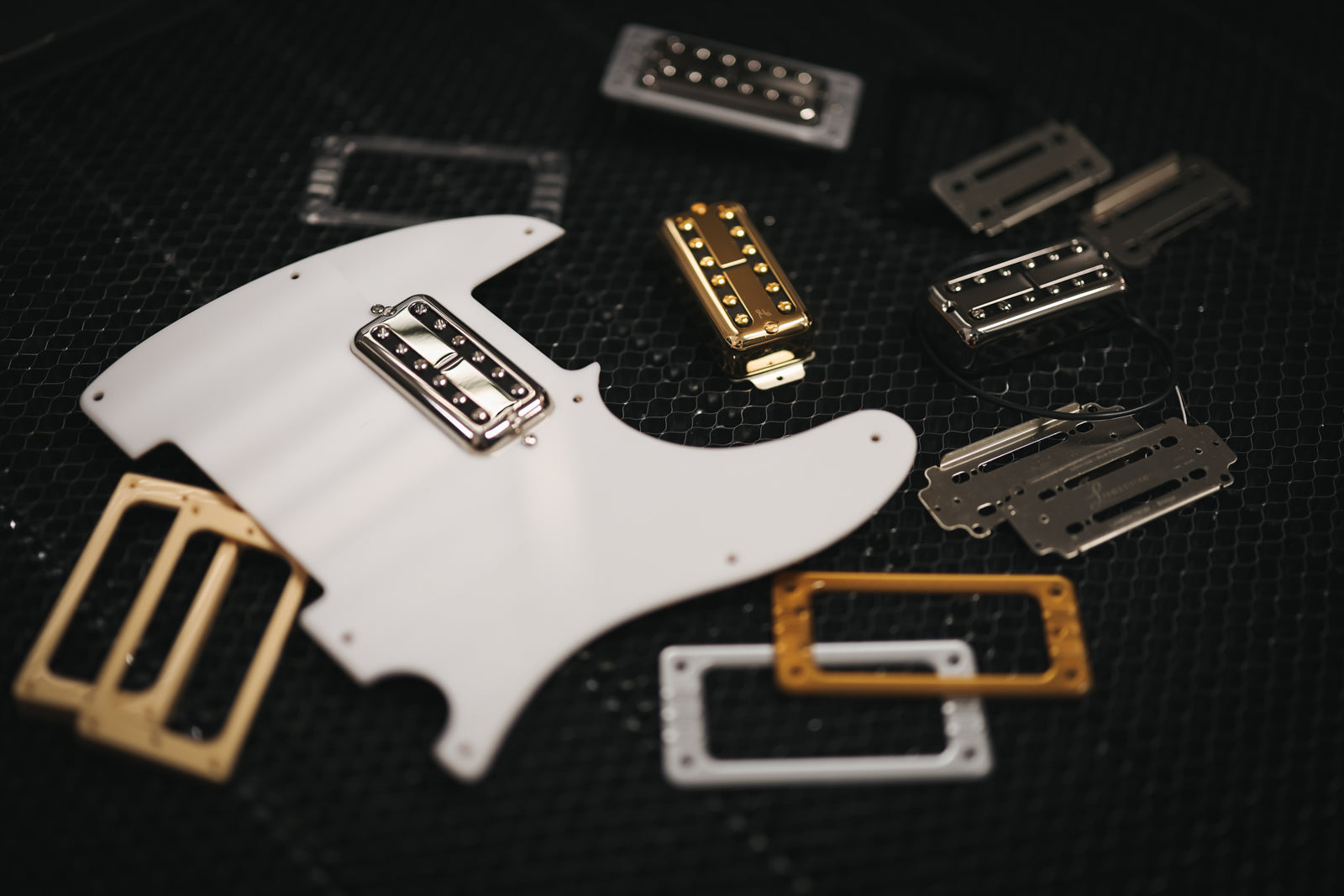
Best Guitar Tone: Is There One?
Great guitar tone is inspiring. It grabs your attention, stirs emotion, and inspires creativity. Whether you're a player chasing the perfect sound, a builder shaping tone from raw components, or a producer dialing in a live or post mix. Let’s be honest, guitar tone is why most of us fell in love with this craft in the first place.
In this post, we’re diving into what makes the good guitar tone great. The qualities that define it, and how you can start shaping your own tone into something truly next-level.

Best Guitar Tone: Is There One?
What is the best guitar tone, and how do you even define it? Is it tied to a genre, a specific player, or a golden era of music? These are the questions we’ve been tossing around at the shop lately, and we even asked a few guitarists to share their thoughts.
While there’s no single answer because let’s face it, great tone has shown up every decade, and across countless styles, we have started to notice a common thread. In our eyes and ears, the best guitar tone isn’t just a sound. It’s a stage along the gain spectrum. It’s a moment of musical tension. It’s a ledge, a balancing point.
And more often than not, it’s the edge of breakup that pulls us in. That sweet spot where clean tone starts to give way to grit, where dynamics shine and emotion pours out of every note. That’s where the magic happens.

What Is Guitar Tone
So what exactly is guitar tone? As we’ve covered in previous posts, guitar tone refers to the overall character of the sound your guitar produces. It’s shaped by a mix of factors, including your playing technique, your gear setup, and the path your signal travels. When your fingers hit the strings, the ferrous metal in those strings vibrates, disturbing the magnetic field created by your electric guitar pickups, creating a tiny, tiny, tiny electrical signal. That signal moves through your volume and tone pots, through your pedals via cables and buffers and boosts, hits an amplifier, and finally comes out through a speaker where your ears and body experience the sonic result.
But just because a frequency is amplified doesn’t mean it sounds good. Tone is highly personal and subjective, and what sounds amazing to one player might sound harsh or flat to another. That said, much like recognizing a skilled player, we often have a gut sense of when tone feels right… (insert stank face here) and when it doesn’t.You can learn about the foundations of tone by reading our post on how to get a good guitar tone here.

We surveyed 130 guitarists to get a sense of where players land when it comes to the best guitar tone. An overwhelming 72% said their favorite sound lives at the edge of breakup, that magical space where the signal is just starting to distort, but still retains clarity and responsiveness.
In contrast, only 6% of players chose dynamic clean tone as their top pick. That’s not to say clean tone isn’t beautiful—it absolutely is. Clean tones can be glassy, articulate, and full of headroom, especially in funk, jazz, or ambient genres. But they don’t always provide the same emotional tension or tactile feedback that edge-of-breakup tones deliver.
At the other end of the tonal spectrum, high-gain or compressed lead tones came in at just 4% of responses. These tones are incredibly important for heavier genres like metal, hard rock, and modern prog; genres we absolutely love, but they tend to offer less dynamic range. If you’ve ever tried to dial in a clean tone using high output pickups or a high-wattage solid state amp, you know it’s much easier to add grit and saturation than it is to take it away. Once your signal is heavily compressed and distorted, recovering touch sensitivity, tonal nuance, or note clarity becomes a challenge.
The edge of breakup gives players something different. It responds to how you play. Pick the strings lightly and it stays clean; dig in and it starts to growl back with character. Add some delay and reverb into the mix, and now you have a dynamic sonic cloud that rumbles and sparkles organically - a tone very much pioneered by the praise and worship industry. Edge of breakup tones are expressive, raw, and incredibly musical, almost like having a third hand controlling your dynamics. That’s why many iconic tones throughout history, from blues and rock to modern indie, live right on this threshold of the edge of breakup.
So while tone is undeniably subjective, and every player’s journey is unique, the edge of breakup seems to be a unifying sweet spot. It’s a place where the signal becomes more than just a sound. It becomes our voice.

How To Get The Best Guitar Tone
So, how do we do it? How do we walk that tightrope between sweet and gritty, clean and saturated, to let our tone sing with dynamic expression? Achieving that edge of breakup sound isn’t about a single setting or magic pedal (but I will be talking to my friends and Strymon and Browne Amplification about this ASAP), it’s a blend of foundational elements working together. It’s the sum of your pickups, pedals, amp, and playing style. A balance of components, working together, impacting each other, but following a few thoughtful processes can help you identify if your current rig is set up for edge of breakup success, or if you have some tweaking to do with your rig's settings or component compatibility overall.

What Is The Best Guitar Tone Settings
While there are various ways to arrive at that tonal sweet spot, here are a few simple guidelines to help you get familiar with dialing in an edge of breakup tone, and guess what?! It all starts with your guitar pickups! So let's get familiar with our specs and learn how to adjust our setup based on what we have to work with.
High-output pickups (12k ohms and up):
While DC resistance isn’t the only factor in determining output, it's a helpful starting point. With high-output pickups, your signal is already hot, meaning it’s much easier to push your amp into saturation, sometimes too far. You’ll need a very clean signal path to retain any remaining clarity. This is arguably the hardest setup to balance for edge of breakup tones. Compression pedals and multiple gain stages can quickly push your tone into full distortion, so instead, aim for a clean boost, either via a pedal or at the amp level, roll that volume knob back a bit, and use a high-wattage tube amp (think 40-50 watts or more), which will be able to provide the necessary headroom. Avoid small amps in the 5–15 watt range because they’ll distort too easily and you’ll just end up with noise.
Medium-output pickups (7–10k ohms):
This range gives you more room to experiment. You can introduce subtle gain and color without overwhelming the tone. A low-gain overdrive like the blue side of a Bluesbreaker-style pedal works great here. Make sure to use more level than drive to enhance your signal, so you don’t push it completely over the edge. Depending on how much compression and gain you're adding in the preamp stage, you can pair this setup with a higher-wattage amp for more clean headroom, or a mid-powered amp (15–30 watts) to begin teasing speaker breakup into your tone.
Low-output pickups (3–6k ohms):
Most of the Lambertones lineup lives in this category, and for good reason. Lower output pickups give you the most flexibility to shape your tone upward, allowing you to build layers of compression, boost, and drive without sacrificing note clarity. This setup is ideal for exploring edge of breakup sounds. You can experiment with soft clipping overdrives like the green side of a Bluesbreaker, Klon-style circuits, or light boost pedals. Tone purists might even use the ULTIMATE Boss DS-1 Distortion for this kind of tone… jk, let’s just say it’s probably best to leave that one out of your chain if you’re after subtlety. 😅
Just remember: pairing low-output pickups with a super clean, high-wattage amp, like a 100W Fender-style amp, might result in no breakup at all. Instead, you’ll get massive, sparkling cleans for days. Huge tone, but not the gritty edge you might be seeking.

We designed the Crema humbucker set for the ultimate platform for edge of breakup humbucker tones. It's our flagship model for a reason, so if you're curious about what those pickups could do for your signal chain, check out our Crema humbuckers here!
The edge of breakup isn’t a preset. It’s not tied to a pedal brand, pickup winder, or a specific amp setting. It’s a feeling, a point where your gear responds to your hands, where subtle changes in attack or dynamics cause your tone to bloom, bite, or back off.
Whether you’re using boutique gear or rocking a Guitar Center special, the key is balance. Pay attention to how your pickups interact with your signal chain, and experiment with adjusting your guitar volume, pickup height, and gain staging. The goal is to create a tone that moves with you, stays clean when you whisper, and roars when you dig in. That’s the magic. That’s the edge of breakup.



Leave a comment
This site is protected by hCaptcha and the hCaptcha Privacy Policy and Terms of Service apply.